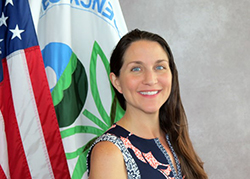Consumption by Tribes of Plants and Animals Not Accounted for in EPA Superfund Risk Assessment Methodology
Sponsored by: US EPA OLEM OSRTI
Archived: Wednesday, June 3, 2020
Consumption by Tribes of Plants and Animals Not Accounted for in EPA Superfund Risk Assessment Methodology
2020-06-03
US EPA OLEM OSRTI
This webinar will describe the process and results from a research project concerning two issues that arise when assessing risks from contamination at Superfund sites. The first area of focus analyzed information from Superfund risk assessments and other publicly available studies on fruit and vegetable consumption by Native Americans that are outside of the twenty-four produce categories EPA includes in risk assessment models used to develop cleanup levels for residential gardens and farms at radioactively contaminated Superfund sites. The second area of focus of the project analyzed the sources for information on animal consumption by Native Americans that is outside of the twelve farm animal categories in EPA's risk assessment models.
Accessibility, Recording, and Content Disclaimer
Rehabilitation Act Notice for Reasonable Accommodation
It is EPA's policy to make reasonable accommodation to persons with disabilities wishing to participate in the agency's programs and activities, pursuant to the Rehabilitation Act of 1973, 29 U.S.C. 791. Any request for accommodation should be made to Jean Balent at 703-603-9924 or balent.jean@epa.gov, preferably one week or more in advance of the webinar, so that EPA will have sufficient time to process the request. EPA would welcome specific recommendations from requestors specifying the nature or type of accommodation needed. Please note that CLU-IN provides both alternate phone call-in options and closed captioning for all webinars, and requests for these specific accommodations are not necessary.
Webinar Recording
By participating in this CLU-IN webinar, you automatically agree to authorize recording of audio and visual content presented during this live event and consent to subsequent use of this recording in the public domain by the U.S. Environmental Protection Agency. This recording may include questions, comments and poll responses provided by you during the live event in addition to your name, voice, image or likeness. This recording will be made available after the conclusion of the live event as part of the CLU-IN webinar archives, and will remain available indefinitely. If you do not wish to consent to the recording, please do not join the live event, and contact Jean Balent at 202-566-0832 or balent.jean@epa.gov to discuss your concerns.
Content Disclaimer
This webinar is intended solely to provide information to the public. The views and opinions expressed as part of this webinar do not necessarily state or reflect those of the U.S. Environmental Protection Agency. It is not intended, nor can it be relied upon, to create any rights enforceable by any party in litigation with the United States, or to endorse the use of products or services provided by specific vendors. With respect to this webinar, neither the United States Government nor any of their employees, makes any warranty, express or implied, including the warranties of merchantability and fitness for a particular purpose, or assumes any legal liability or responsibility for the accuracy, completeness, or usefulness of any information, apparatus, product, or process disclosed, or represents that its use would not infringe privately owned rights.
Presenters:
 Stuart Walker, U.S. EPA Office of Superfund Remediation and Technology Innovation (walker.stuart@epa.gov)
Stuart Walker, U.S. EPA Office of Superfund Remediation and Technology Innovation (walker.stuart@epa.gov)
Stuart Walker has been employed by U.S. EPA in Washington, DC since 1990 in either the Superfund program (the Office of Superfund Remediation and Technology Innovation) or the Office of Radiation and Indoor Air working on issues regarding the cleanup of contaminated sites. His primary area of responsibility includes serving as the Superfund program's national lead on issues regarding radioactively contaminated CERCLA sites. In this role, Stuart develops national policy for risk assessment including models, community involvement, compliance with Applicable or Relevant and Appropriate requirements (ARARs), establishing cleanup levels and management of radioactive contamination at CERCLA sites.
 Grace Maley, U.S. EPA Intern
Grace Maley, U.S. EPA Intern
Grace Maley is finishing her third year at Middlebury College where she is majoring in Environmental Economics with a minor in Mathematics. This project is a part of her year-long internship with the EPA Office of Superfund Remediation and Technology Innovation.
Moderator:
 Jean Balent, U.S. EPA Technology Innovation and Field Services Division (balent.jean@epa.gov or 202-566-0832)
Jean Balent, U.S. EPA Technology Innovation and Field Services Division (balent.jean@epa.gov or 202-566-0832)
Ms Balent is on the staff of the EPA's Technology Innovation and Field Services Division where she has worked to collect and disseminate hazardous waste remediation and characterization information since 2003. Ms Balent manages the Clean Up Information Network website and actively supports online communication and collaboration resources available to EPA. She formerly worked with the US Army Corps of Engineers Environmental Engineering Division in the Buffalo District. Ms Balent was also a member of the SUNY-Buffalo Groundwater Research Group where she constructed and tested large scale models of groundwater flow. Ms Balent has also conducted research relating to the Great Lakes, environmental remediation, and brownfields re-development. She holds a Bachelor's degree in environmental engineering from SUNY-Buffalo and a Master's degree in Information Technology from AIU.
Webinar Slides and References:
Webinar Slides and References:
Additional Resources:
 Evaluating Produce Consumption by
Native Americans for Risk Assessments (1.4KB/23pp/PDF)
Evaluating Produce Consumption by
Native Americans for Risk Assessments (1.4KB/23pp/PDF) Evaluating Food Consumption Associated with Fishing and Hunting by Native Americans for Risk Assessments (2.1KB/19pp/PDF)
Evaluating Food Consumption Associated with Fishing and Hunting by Native Americans for Risk Assessments (2.1KB/19pp/PDF) Evaluating Tribal Dietary, Lifestyle, and Ceremonial Exposures for Use in EPA Superfund Risk Assessments (3.1KB/40pp/PDF)
Evaluating Tribal Dietary, Lifestyle, and Ceremonial Exposures for Use in EPA Superfund Risk Assessments (3.1KB/40pp/PDF)
If you have a suggested topic or idea for a future CLU-IN internet seminar, please contact:
Technology Integration and Information Branch
PH: 202-566-0832 | Email: balent.jean@epa.gov
Technology Integration and Information Branch
PH: 202-566-0875 | Email: adam.michael@epa.gov




